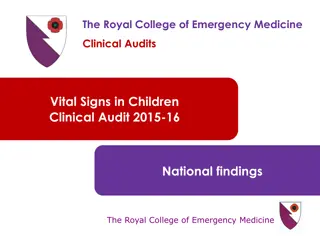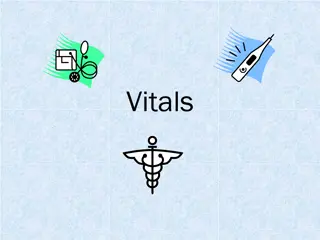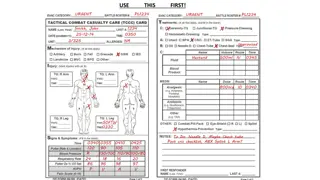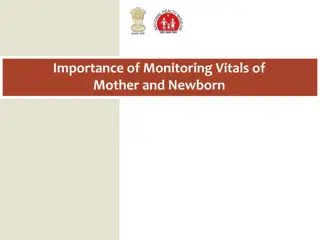Understanding Vital Signs in Patient Assessment
Vital signs play a crucial role in assessing an individual's physical functioning. Observing and measuring parameters such as temperature, respiratory rate, pulse, blood pressure, pain levels, and oxygen saturation can provide valuable insights into a patient's health. Prior to taking measurements, it's important for patients to sit and relax for a few minutes. Observational cues, such as signs of anxiety or distress, can also inform healthcare professionals during the assessment process. Different demographic groups may exhibit variations in temperature perception, emphasizing the importance of individualized care.
Download Presentation

Please find below an Image/Link to download the presentation.
The content on the website is provided AS IS for your information and personal use only. It may not be sold, licensed, or shared on other websites without obtaining consent from the author. Download presentation by click this link. If you encounter any issues during the download, it is possible that the publisher has removed the file from their server.
E N D
Presentation Transcript
General Vital signs
Vital sign Vital sign Temperature respiratory Pulse Blood pressure orientation Pain oxygen saturation.
Vital sign These signs may be observed, measured, and monitored to assess an individual's level of physical functioning.
Vital sign All measurements are made while the patient is seated.
Vital sign Prior to measuring vital signs, the patient should have had the opportunity to sit for approximately five minutes.
Observation Before diving in, take a minute or so to look at the patient in their entirety.
Observation Does the patient seem anxious, in pain, upset? What about their dress and hygiene? Remember, the exam begins as soon as you lay eyes on the patient.
Temperature Vital signs
. . 99/6 . 96/6 37/4 98/6 35/9 .
Rectal Thermometer See bigger picture
Temperature Old people, people with disabilities, babies and young children typically feel more comfortable at higher temperatures.
Temperature Women notice that they are feeling cool quicker than men, which may be related to their different body size.
Temperature The normal body temperature of a person varies depending on gender, recent activity, food and fluid consumption, time of day, and, in women, the stage of the menstrual cycle.
Temperature Temperature is measured in either Celcius or Farenheit
Temperature Rectally temperatures taken rectally (using a mercury or digital thermometer) tend to be 0.5 to 0.7 (Fahrenheit) higher than when taken by mouth.
Temperature Oral temperature can be taken by mouth using classic glass mercury-filled or digital thermometers.
Temperature Axillary temperatures can be taken under the arm. Temperatures taken by this route tend to be 0.3 to 0.4 (Fahrenheit) lower than those temperatures taken by mouth.
Temperature By ear a special thermometer can quickly measure the temperature of the ear drum, which reflects the body's core temperature.
Fever or pyrexia or hyperpyrexia 41 105 .
Hypothermia Hypothermia is defined as a drop in body temperature below 35/9 . If drop below 34 death
Respiration rate Vital signs
What is the respiration rate? The respiration rate is the number of breaths a person takes per minute.
Respiratory Rate Try to do this as surreptitiously as possible. Observing the rise and fall of the patient's hospital gown while you appear to be taking their pulse.
Respiratory Rate They should be counted for at least 30 seconds 15 second period is rather small and any miscounting can result in rather large errors when multiplied by 4.
Respiratory Rate Respiration rates may increase with fever, illness, . When checking respiration, also note whether a person has any difficulty breathing.
Abnormal Respiratory Rate Respiration rates over 25 or under 12 breaths per minute (when at rest) may be considered abnormal under 12 breaths over 25 breaths
Respiratory Rate Normal respiration rates at rest range from 15 to 20 breaths per minute. In the cardio- pulmonary illness, it can be a very reliable marker of disease activity. 15 20
Pulse Vital signs
Pulse rate The normal pulse for healthy adults ranges from 60 to 100 beats per minute.
Pulse rate The pulse rate may fluctuate and increase with exercise, illness, injury, and emotions. Girls ages 12 and older and women, in general, tend to have faster heart rates than do boys and men.
Pulse rate Athletes, such as runners, may have heart rates in the 40's and experience no problems.
How to check your pulse You feel the beats by firmly pressing on the arteries, which are located close to the surface of the skin at certain points of the body.
How to check your pulse The pulse can be found on the side of the lower neck, on the inside of the elbow, or at the wrist.
Pulse Place the tips of your index and middle fingers just proximal to the patients wrist on the thumb side, orienting them so that they are both over the length of the vessel.
Pulse Push lightly at first, adding pressure if there is a lot of subcutaneous fat or you are unable to detect a pulse. If you push too hard, you might occlude the vessel and mistake your own pulse for that of the patient.
Pulse: Quantity Measure the rate of the pulse (recorded in beats per minute). Count for 30 seconds and multiply by 2 (or 15 seconds x 4).
Pulse: Quantity If the rate is particularly slow or fast, it is probably best to measure for a full 60 seconds in order to minimize the error.
Pulse: Regularity Is the time between beats constant?. Irregular rhythms, are quite common.
Pulse: Volume Does the pulse volume feel normal? This reflects changes in stroke volume. In hypovolemia, the pulse volume is relatively low

















































